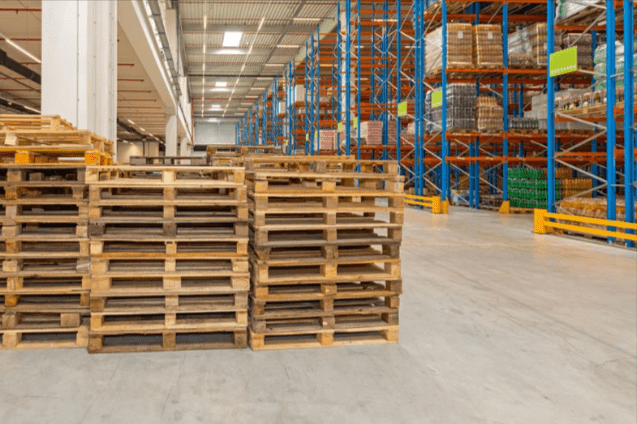Why Maximum Pallet Height for Shipping Matters

Get your freight delivered safely. Contact us to request a professional shipping quote from Tim Savage Trucking today. Shipping pallets without considering the maximum pallet height for shipping leads to dangerous situations, damaged cargo, and heavy fines. If you ship in Utah, Wyoming, New Mexico, California, or Arizona, pallet height matters for safety, cargo integrity, and compliance. Let’s examine how respecting pallet height ensures your business runs smoothly and your team remains safe.
Understanding the Maximum Pallet Height for Shipping
The term “maximum pallet height for shipping” refers to the tallest a loaded pallet can be and remain safe, stable, and compliant with both company and legal guidelines. Exceeding this height can risk injuries, freight loss, and regulatory issues. Most shipping providers adhere to standard industry height limits, typically ranging from 48 to 60 inches, although these limits can vary depending on the cargo, equipment, transport method, and regional standards.
Why does this matter so much? High pallets can become unstable, topple during movement, or get rejected by carriers. Regulatory inspectors take height seriously, especially with the Southwest’s busy freight corridors. For businesses across Utah, Wyoming, New Mexico, California, and Arizona, keeping tabs on your pallet’s height maximizes safety, reduces claims, and protects your bottom line.
If you need a trusted team to handle your freight, explore our Pallet Shipping Services for expert help with best practices and safe delivery.
How the Maximum Pallet Height for Shipping Impacts Safety
Ignoring the maximum pallet height for shipping carries real risks. When pallets are stacked too high, the load’s center of gravity rises—think of a tower of blocks that’s more likely to tip over. Forklift drivers lose clear sight lines, making accidents more likely. A tall, overloaded pallet can shift easily and collapse onto people or equipment.
Tall pallets often cause:
- Tipping and falling in transit
- Obstructed forklift operator view
- Split or broken pallets from excess pressure
- Goods crushed or damaged during shipping
Every type of cargo has different needs. Fragile goods might buckle under the weight if stacked too high. Heavy products could break lower boxes or create unsafe bulges in the shrink wrap. In high-traffic warehouses or during loading and unloading, these hazards multiply, putting your workforce and investment at risk.

Industry Height Recommendations and Regulations
The most common recommendations for maximum pallet height for shipping fall between 48 and 60 inches, measured from the floor to the highest point of the load, including the pallet base. The Federal Motor Carrier Safety Administration (FMCSA) and Occupational Safety and Health Administration (OSHA) stress maintaining stable loads and avoiding unstable stacking that could endanger employees or the public.
Special shipments, such as hazardous materials or unusually tall freight, may have stricter height rules—especially in Southwest shipping lanes where routes run through Utah, Wyoming, New Mexico, California, and Arizona. Local carriers also enforce limits based on trailer door clearance, racking systems in warehouses, and vehicle weight distribution.
Always check for unique requirements by product type. For instance:
- Hazardous materials may have lower thresholds
- Double-stacked shipments need careful planning
- Food and produce loads often face height caps for ventilation
Paying attention to these guidelines helps avoid shipment delays, cargo damage, and regulatory penalties.
Best Practices for Safe Pallet Height and Secure Shipping Loads
Maintaining the maximum pallet height for shipping ensures the protection of your cargo, workers, and reputation. Use these tips to stack, pack, and wrap smarter:
- Stack boxes evenly with the heaviest items on the bottom
- Never exceed weight ratings for pallets or stretch film
- Keep loads square and avoid things that lean or bulge out
- Use quality wrapping: shrink wrap, banding, or strapping to secure the load
- Label pallets with clear height and weight markings
For trickier shipments or if your team’s unsure about height restrictions, our experts at Tim Savage Trucking can walk you through smarter loading, safe heights, and compliance rules. Discover more solutions on our Freight Transport Services page to make the most of every shipment.
How to Measure and Maintain Safe Pallet Height
Measuring pallet height isn’t complicated, but accuracy makes all the difference. Here’s a quick process for warehouse teams:
- Place the loaded pallet on a flat surface.
- Use a tape measure from the floor (not just the pallet top) to the highest point on the load.
- Record the total height, including extra wrap or overhanging items.
- Check against carrier or regulatory standards before moving it to the staging area.
- Repeat with every new shipment or load change.
Add a checklist for team members:
- Confirm pallet height is within the allowed range
- Inspect for leaning, bulging, or improperly secured loads
- Tag or flag pallets outside the safe height for rework
Keeping a simple log or digital record also helps maintain compliance history and reduces disputes with carriers or regulators.

The Risks of Ignoring the Maximum Pallet Height Guidelines
Skipping or pushing the limits of maximum pallet height for shipping leads to headaches fast:
- Damaged cargo: Boxes fall, products break, shrink wrap splits, or items get lost in transit
- Rejected shipments: Carriers refuse oversized pallets, causing delays and extra fees
- Fines and penalties: Regulatory agencies can issue costly citations for repeated safety violations
- Serious safety incidents: Pallets toppling in a warehouse or during unloading can harm staff, equipment, or customers
Picture a Utah warehouse where a pallet stacked too high loses stability and topples while being loaded. Not only do you face lost products, but an injured employee and an OSHA investigation. Similar scenarios play out in New Mexico, Arizona, California, or Wyoming—if you disregard height guidelines, both the load and business reputation are at risk.
Protect Your Freight and Your Team by Following Maximum Pallet Height Guidelines
Respecting the maximum pallet height for shipping ensures your shipments are secure, your staff is safe, and your business remains compliant. It’s a simple step that protects both products and people every day.
For peace of mind on your next load, request professional pallet shipping assistance from Tim Savage Trucking. Our team is familiar with the rules, understands the risks, and consistently delivers safely. For expert answers and fast freight support, contact our shipping experts today and move your business forward.

